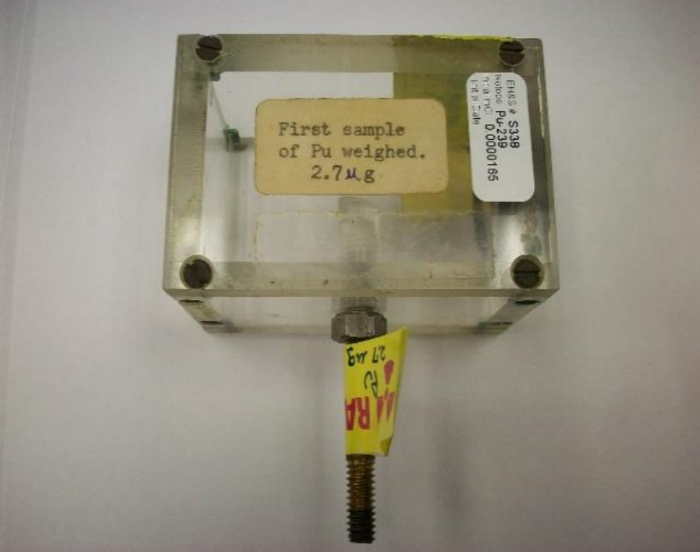
Extracted by Manhattan Project researchers back in the 1940s, this is
the first piece of plutonium ever seen by human eyes, and it's just been
saved from a university waste repository.
When
America's ‘Fat Man’ atomic bomb was dropped onto Nagasaki in Japan in
1945, wounding more than 60,000 people and killing over 35,000, it
contained just over 6 kilograms of pure plutonium. The discovery of this
incredibly devastating radioactive metal has been traced to a lab at
the University of California, Berkeley in the US, where Manhattan
Project researchers managed to extract the world’s first barely visible
sample.
It was in 1941 that trace amounts of plutonium were first
chemically separated from a sample of uranium by scientists Glenn
Seaborg, Arthur Wahl and Joseph Kennedy. Previously known as ‘element
94’, the team officially named their newly extracted element, and over
the next 18 months, performed a whole bunch of experiments on the trace
amounts to get an idea of its chemical and nuclear properties.
But
soon enough, these minuscule traces were not enough, and Seaborg’s team
set out to produce the world’s first chunk of pure plutonium. They
didn’t need much - the size of a pin-head would do - and they figured
out how to make enough by first producing neutrons by smashing samples
of the element beryllium with accelerated deuteron particles. These neutrons were then used to irradiate several kilograms of uranium inside a type of particle accelerator called a cyclotron, and the result of the decay was a sample of plutonium weighing around 2.77 micrograms (µg). That’s about three millionths of a gram.
On
10 September 1942, Seaborg’s team announced that they had produced the
world’s first sample of pure plutonium. “They could actually see it,” UC
Berkeley nuclear engineer Eric Norman told Andy Extance at Scientific American, who was recently tasked with authenticating it. “No one had ever seen plutonium before.”
Seaborg would go on to win the Nobel Prize for chemistry in 1951 for the discovery of plutonium and several other transuranium elements, and once his team was done with the sample, they sealed it inside a glass tube inside a clear plastic box.
From
1979 onwards, the plutonium chunk was displayed in the science faculty
at UC Berkeley, until the late 2000s when concerns about radiation
safety and financial cut-backs saw it removed. In 2008, a box labelled
“First sample of Pu weighed. 2.7 µg” was found in the university’s
Hazardous Material Facility and flagged as something that possibly
shouldn’t be processed as radioactive waste by UC Berkeley health
physicist, Phil Broughton.
Broughton delivered the mysterious box
to Norman and his colleagues that year, who were suddenly faced with the
task of authenticating the long-forgotten piece of Manhattan Project
plutonium - the first piece of plutonium ever viewed by human eyes - so
the Smithsonian Institution Museum in Washington, DC could take it
on. “This is the equivalent to the original Moon rock,” Norman told Extance, except their were no records left to prove it.
So
how do you prove a sample’s authenticity without risking its
destruction? It took six years for Norman to get a team from the
university's Department of Nuclear Engineering together to figure this
out, and they decided that whatever they did, they were not opening the
box. So they had to do all their tests externally by reading the gamma
rays and X-rays it would be expected to emit as part of the process of
decaying to uranium.
“[The box] was placed approximately 6.3 mm
away from the front face of a 36-mm diameter by 13-mm thick planar
germanium detector,” they describe in their paper, pre-published online at arxiv.org.
"This detector is equipped with a thin beryllium window allowing
detection of low-energy gamma rays and X-rays. The detector was shielded
with 1.27 cm of copper and 5 to 10 cm of lead. The box was counted for
21.2 hours. The box was then removed and a background spectrum was
collected for 21.3 hours.”
"It turns out that plutonium created in
a cyclotron is very different from most plutonium, which is created
inside nuclear reactors and then separated from spent nuclear fuel," the Physics Arxiv Blog explains.
"That's because this stuff always contains another isotope,
plutonium-241. This is a half-life of just over 14 years and decays into
americium-241. So samples of plutonium from nuclear reactors, always
contain americium-241 in amounts that grow over time. What's more,
Am-241 in turn decays producing gamma rays with an energy of 59
kiloelectron volts."
Now,
before you panic, the sample, though radioactive, is perfectly safe to
be around. And while its discovery led to the development of a bomb that
would devastate the lives of hundreds of thousands of people, we can't
deny that, like the Moon rock, it's literally a piece of human history.
 Eric B. Norman et. al.
Eric B. Norman et. al.
No comments:
Post a Comment